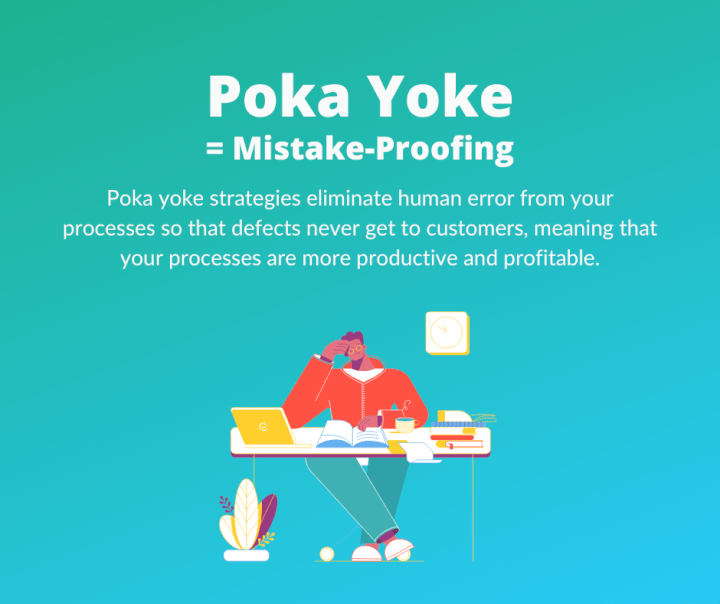Poka yoke definition
Poka yoke is a fundamental tool of Lean Six Sigma that refers to strategies that prevent mistakes from occurring in a process. Poka yoke strategies eliminate human error from your processes so that defects never get to customers, meaning that your processes are more productive and profitable.
If you’re in a position where you want to use Lean methods, then poka yoke is one of the tools that you’re going to want in your belt.

Poka yoke is often divided into two approaches to prevent or detect defects:
The control approach: where a process stops when a defect occurs and doesn’t resume until there is a corrective action. For example, elevator doors use sensors to prevent the door from closing if there is something in the way. The elevator doors can not close until the obstruction is removed, and the elevator remains stationary.
The warning approach: where you are given a warning that a defect has occurred, so you can fix it. For example, many cars will emit beeping noises if you have not fastened your seatbelt or shut your door properly. These noises will not stop until you have taken corrective action.
How to pronounce poka yoke
Most native speakers of English will see the word “yoke” and assume that the “e” is silent so that the word rhymes with familiar constructions like “poke” and “joke.”
The Japanese term for prevent or proof is two syllables. As it would be spoken in Japanese, the pronunciation for poka yoke sounds like:
Poh-kah (rhymes with “mocha”) YOH-kay (rhymes with “okay”).
History of poka yoke
The story of poka yoke begins in Japan. In 1943, Taiichi Ohno joined the Toyota Motor Company. The Toyota Motor Company was relatively new at the time, an offshoot of Toyoda Spinning and Weaving.
As he rose through the ranks at Toyota, Ohno would partner frequently with Shingeo Shingo. These two minds are credited with the implementation of strategies like poka yoke that would come to be widely known as the Toyota Production System (TPS).
In his book Zero Quality Control: Source Inspection and the Poka Yoke System, Shingeo Shingo relates a story from the early days of practicing poka yoke that has come to be told as the earliest formal example of the tool.
In 1961, Shingo was visiting an electronics plant where a device was assembled with two buttons. When assembled properly, each button covered a spring, but the plant manager explained that leaving out a spring was a common defect in the finished devices. Once the buttons were in place, a simple visual inspection of the device would not reveal whether the springs were present or not.
Shingo and the employees at the plant devised a process by which two springs would be placed on a dish before assembly began. Then, if a spring was still in the dish after the switches were in place, the worker would know that a spring had been left out of the device.
This early example of mistake proofing is an example of the warning approach to poka yoke. If a spring was in the dish after the device was assembled, then the worker was warned that the device was incomplete, and the defect could be fixed before the device went to the customer.
At the time of his engagement with the electronics plant in 1961, Shingo had been working on process improvements for over a decade. That work would continue for the rest of his life, including the publication of eight books in his lifetime and credit in several posthumous works.
In addition to being one of the pillars of the TPS, the concept of poka yoke proved so valuable that it also became one of the pillars of lean manufacturing. If you’re interested, we also have a list of other important Lean Six Sigma tools and techniques.
Want to learn more about the Lean Six Sigma methodology?
Check out this ebook that will guide you through the key concepts of LSS.
The importance of poka yoke
To overstate the effect of poka yoke on modern manufacturing and modern society would be hard to do. In general, organizations practice this principle to improve productivity.

If we start with a historical example, we find that in 1998, not so long after AT&T Power Systems became the first company in the United States to win a Deming Prize, part of their achievement was a culture that used roughly 3,300 poka yoke devices.
This enabled average savings of over $2,500 per device. While the numbers might not be as gaudy for smaller companies, poka yoke is a vital part of quality efforts in all kinds of industries. Here are a few recent examples:
- Quality Magazine describes how software and the Internet of Things (IoT) are making their way into poka yoke efforts.
- Bălan and Janłă describe poka yoke efforts that improve the productivity of a process that produces a transport pallet.
- Software Testing Help talks about poka yoke in the software industry and shows examples of mistake proofing by Google.
Poka yoke continues to prove itself as a tool that improves processes and reduces defects.
When to use poka yoke
In general, poka yoke is an effective strategy to use whenever a mistake is possible. Poka yoke can be effective at any stage of a process, as long as human error can lead to preventable defects.
The defects that we prevent with poka yoke strategies need to be the results of the potential for human error, not the result of process incapability.

If we return to the original story that Shingo tells in Zero Quality Control: Source Inspection and the Poka Yoke System, we’ll notice an important feature of when poka yoke is traditionally thought of as most valuable. Shingo writes:
“Whenever I hear supervisors warning workers to pay more attention or to be sure not to forget anything, I cannot help thinking that the workers are being asked to carry out operations as if they possessed divine infallibility. Rather than that approach, we should recognize that people are, after all, only human and as such, they will, on rare occasions, inadvertently forget things. It is more effective to incorporate a checklist--i.e., a poka yoke--into the operation so that if a worker forgets something, the device will signal that fact, thereby preventing defects from occurring. This, I think, is the quickest road to attaining 0 defects.”
In this manner, Shingo explains that the purpose of a poka yoke device is to prevent human error, to prevent the occasional mistake that humans make when they must do a repetitive task, leading to quality problems. This means that the defects that we prevent with poka yoke strategies need to be the results of the potential for human error, not the result of process incapability.
Poka yoke example
Michel Baudin provides an interesting example for identifying a case where poka yoke could be seen as more useful or less useful at the 2011 Lean Management Solutions Conference in St. Louis, Missouri, USA.
In Baudin’s example, a worker uses a machine to dispense a pound of oil, but the example would work with any opaque container. Baudin proposes that if the machine that the worker is using sometimes dispenses 0.5 pounds and sometimes 2.5 pounds instead of 1 pound, then using a poka yoke device to decrease human error is paying attention to the wrong problem.
The precision and accuracy of the process to dispense oil have to be satisfactory before it’s worth using poka yoke to prevent human errors. The problem of getting the machine to operate in a satisfactory way has to be present before a poka yoke strategy would be effective.
If the machine that dispenses oil is accurate and precise, then a possible problem is that a human might either forget to fill a part or fill a part twice. The finished product with too little or too much oil would be a defect. At this point, a way to prevent human errors from introducing defects could be useful.
If we imagine the auto parts moving one-at-a-time down a conveyor belt, then we can imagine how a worker might make an inadvertent error and occasionally fill a part twice or not fill a part. A scale that was capable of telling correctly-filled parts from either of these error conditions, located just after the place where the worker filled the parts, could identify when an error was made.
This scale could warn the worker and stop the conveyor belt until the part was removed for rework. Thus, the poka yoke device would be functioning correctly based on preventing human error, rather than process incapability.
Learn more
GoSkills offers a variety of certification courses that can help you learn more about Lean tools and techniques.
To learn more, try our Lean Six Sigma Yellow Belt course that can prepare you to earn accreditation through IASSC/PeopleCert.
Prepare to get certified in Lean Six Sigma
Start learning today with GoSkills courses
Start free trial



